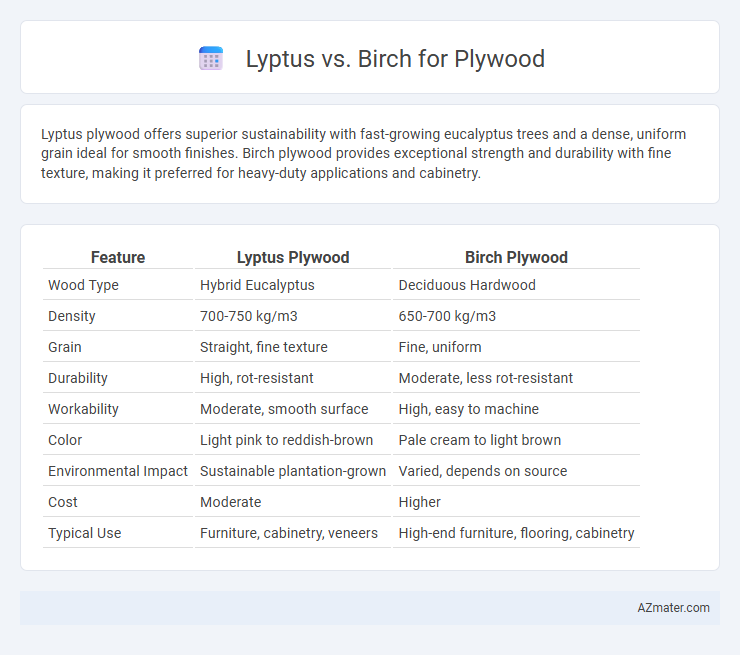Lyptus plywood offers superior sustainability with fast-growing eucalyptus trees and a dense, uniform grain ideal for smooth finishes. Birch plywood provides exceptional strength and durability with fine texture, making it preferred for heavy-duty applications and cabinetry.
Table of Comparison
| Feature | Lyptus Plywood | Birch Plywood |
|---|---|---|
| Wood Type | Hybrid Eucalyptus | Deciduous Hardwood |
| Density | 700-750 kg/m3 | 650-700 kg/m3 |
| Grain | Straight, fine texture | Fine, uniform |
| Durability | High, rot-resistant | Moderate, less rot-resistant |
| Workability | Moderate, smooth surface | High, easy to machine |
| Color | Light pink to reddish-brown | Pale cream to light brown |
| Environmental Impact | Sustainable plantation-grown | Varied, depends on source |
| Cost | Moderate | Higher |
| Typical Use | Furniture, cabinetry, veneers | High-end furniture, flooring, cabinetry |
Introduction to Lyptus and Birch Woods
Lyptus is a fast-growing hybrid hardwood, derived from Eucalyptus grandis and Eucalyptus urophylla, known for its durability and sustainability in plywood manufacturing. Birch, a traditional hardwood sourced primarily from Betula species, offers a fine grain and strength highly favored for high-quality, stable plywood applications. Both woods present unique advantages, with Lyptus excelling in eco-friendly production and Birch prized for its consistent appearance and workability.
Overview of Plywood Manufacturing
Lyptus and birch are popular hardwood choices in plywood manufacturing, each with distinct characteristics that influence production quality. Lyptus, a fast-growing eucalyptus hybrid, offers a consistent grain pattern and high density, resulting in durable and stable plywood panels ideal for furniture and cabinetry. Birch plywood, derived from tightly grained hardwood, provides exceptional strength and smoothness, making it suitable for applications requiring fine finish and structural integrity.
Physical Characteristics: Lyptus vs Birch
Lyptus plywood features a uniform, fine grain with a light reddish-brown hue, offering high density and excellent hardness that enhances durability and resistance to dents. Birch plywood presents a smooth, pale cream to light yellow color with a tight grain pattern, known for its high strength-to-weight ratio and good flexibility. Both woods provide strong structural performance, but Lyptus tends to be denser and harder, making it ideal for heavy-duty applications, while Birch balances durability with lighter weight and ease of machining.
Durability and Strength Comparison
Lyptus plywood offers exceptional durability and high strength due to its dense grain structure and resistance to dents and scratches, making it ideal for heavy-duty applications. Birch plywood, known for its toughness and uniform strength, provides excellent stability and load-bearing capacity, often preferred in furniture and cabinetry. Both woods deliver strong, durable plywood, but Lyptus tends to outperform birch in moisture resistance while birch excels in consistent structural integrity.
Workability and Machining Properties
Lyptus plywood exhibits excellent workability due to its uniform grain and consistent density, allowing for smooth cutting, sanding, and shaping without splintering. Birch plywood is renowned for its fine grain and high strength, providing superior machining properties such as clean edges and precise detailing during routing and drilling. Both species offer reliable performance in woodworking, but Lyptus tends to machine faster with less tool wear, while birch provides enhanced durability for intricate joinery.
Environmental Sustainability and Sourcing
Lyptus plywood, sourced from fast-growing Eucalyptus trees cultivated in certified plantations, offers a renewable alternative with responsible forestry practices that minimize deforestation and promote carbon sequestration. Birch plywood, often harvested from naturally regenerating forests, may face challenges in sustainability due to slower growth rates and variable certification standards, potentially leading to habitat disruption. Both materials require careful consideration of sourcing certifications like FSC or PEFC to ensure environmental sustainability and reduce ecological impact.
Cost Effectiveness and Market Availability
Lyptus plywood offers a cost-effective alternative to birch plywood, often priced lower due to its fast-growing eucalyptus source, making it more affordable for large projects. Birch plywood maintains strong market availability and is preferred for its consistent strength and fine grain, but its price tends to be higher because of limited supply and slower growth rates. Buyers seeking budget-friendly plywood with reasonable durability lean toward Lyptus, while those prioritizing premium quality and stable supply frequently choose birch.
Aesthetic Differences: Color and Grain
Lyptus plywood features a warm reddish-brown hue with a fine, straight grain pattern, offering a visually appealing and uniform appearance ideal for modern interior designs. Birch plywood presents a lighter, creamy color with a smooth, subtle grain that provides a clean and versatile aesthetic suitable for various styles. The color contrast between the rich Lyptus and the pale Birch allows designers to choose based on desired warmth and visual texture for cabinetry and furniture projects.
Typical Applications in Woodworking
Lyptus plywood is commonly used in furniture-making, cabinetry, and decorative panels due to its hardness and smooth grain, offering excellent machinability and a consistent finish. Birch plywood serves well in flooring, shelving, and structural applications where strength and durability are critical, benefiting from its tight grain and resistance to warping. Both materials are favored in woodworking for their stability and aesthetic appeal but differ in cost and workability depending on project requirements.
Choosing the Right Plywood: Lyptus or Birch?
Lyptus plywood offers a sustainable alternative with fast growth and consistent grain, making it ideal for eco-conscious projects requiring uniform strength and smooth finish. Birch plywood provides superior durability, fine texture, and excellent resistance to warping, suited for high-stress applications like cabinetry and furniture. Selecting between Lyptus and Birch depends on project requirements for environmental impact, mechanical strength, and aesthetic preference.

Infographic: Lyptus vs Birch for Plywood
 azmater.com
azmater.com